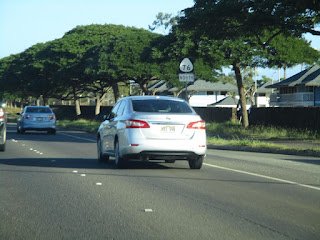Hawaii Route 76 is a 6-mile State Highway located on the Island of O'ahu. Hawaii Route 76 begins at Interstate H-1/Hawaii Route 750 in Waipahu and follows Fort Weaver Road to the boundary of the Fort Weaver Naval Reservation.
Part 1; the history of Hawaii Route 76
The corridor of Fort Weaver Road has been linked to military usage since the U.S. Army acquired land on Ewa Beach during 1905 to support coastline defense. The Army property was transferred to the U.S. Navy during 1916 and came to be known as the Pu'uloa Military Reservation. The coastal defense facility by 1922 took the name of Fort Weaver. Fort Weaver saw the construction of Battery Williston which was completed by 1924. Battery Weaver was added to Fort Weaver upon being completed during 1934.
Prior to the Statehood the first signed highways within Hawaii Territory came into existence during World War II. During World War II the territory of Hawaii saw an influx of military activity following the attack on Pearl Harbor on December 7th, 1941. Numerous Military Routes and early Hawaii Routes were signed through the Hawaiian Territory to aid military personnel in navigating the islands. Military Highways were assigned US Route style shields whereas lesser highways were assigned an early variation of what is now the Hawaii Route Spade. Ewa Beach Road (now Old Fort Weaver Road and Fort Weaver Road) was assigned as Hawaii Route 211 south of Military Route 2/Farrington Highway. Anti-Motor Torpedo Battery #1 was added to Fort Weaver in 1943. A full version of the 1946 Army Map of O'ahu can be seen on hawaiihighways.com here.
Below Hawaii Route 211/Ewa Beach Road can be seen branching from Military Route 2/Farrington Highway.
Hawaii Route 76 can be seen aligned on Fort Weaver Road on the 1959 Gousha Map of Hawaii.
During the 1960s Fort Weaver Road declined in importance and was reassigned as Hawaii Route 760. The triple digit numbering of Hawaii Route 760 denoted it was a Secondary State Highway. Hawaii Route 760 can be seen in the vicinity of Honouliuli on the 1968 USGS Map of the Ewa Area on what is now Old Fort Weaver Road.
According to hawaiihighways.com Fort Weaver Road was realigned as an expressway from the Lower Village of West Loch Estates north of Farrington Hawaii directly to Interstate H-1. Fort Weaver Road was reassigned as Hawaii Route 76 denoting it's restored status as a primary highway. Hawaii Route 76 consumed what had been Hawaii Route 750 from Farrington Highway north to Interstate H-1. The realigned Fort Weaver Road and Hawaii Route 76 can be seen immediately east of Old Fort Weaver Road on the 1998 USGS Map of the Ewa Area.
Hawaii Route 76/Fort Weaver Road begins as an expressway south of Interstate H-1/Queen Liliuokalani. Hawaii Route 76/Fort Weaver Road southbound intersects Farrington Highway via an interchange which accesses Hawaii Route 7101 and Hawaii Route 7110 via Exit 6A. Hawaii Route 76/Fort Weaver Road Exit 5 accesses Waipahu.
During May of 2019 Dan Murphy of the Roadwaywiz YouTube Channel and Gribblenation featured real-time drives on Hawaii Route 76. Below southbound Hawaii Route 76 can be viewed.




















Comments